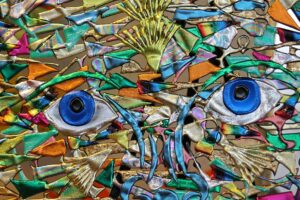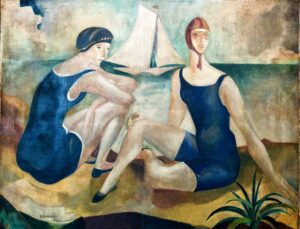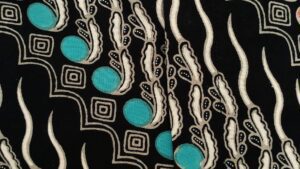In the fusion of art and spirituality, Yoga Western-Style Painting stands out, capturing the essence of tranquility and the fluidity of movement on canvas.
It’s a visual symphony that intertwines the ancient practice of yoga with the bold strokes of Western artistry.
We’ll explore how these paintings not only decorate spaces but also inspire a sense of peace and mindfulness.
jump into the world where brush meets mat, and discover how this art form is more than just a trend—it’s a pathway to inner harmony.
Overview Of Yoga Western-style Painting
Yoga Western-Style Painting is a creative fusion that has captured our fascination with its unique blend of physicality and visual art.
It’s a style that exemplifies the cultural exchange between East and West, with each painting presenting yoga poses ensconced in Western aesthetic principles.
Artists skilled in this genre bring forth canvases that speak of serenity and equilibrium, yet pulsate with the vibrant energy inherent in both yoga and Western artistic traditions.
The compositions often showcase figures frozen in moments of repose or stretching into elaborate asanas, all while embracing elements of Western art styles like Realism or Impressionism.
These paintings serve as more than decoration; they’re a silent guide, encouraging viewers to pause and reflect.
As we jump into the intricate layers of Yoga Western-Style Painting, it’s clear that each brush stroke holds intention and purpose, revealing a story that transcends the canvas.
In exploring the distinct characteristics of this art form:

- Artists combine accurate anatomical forms with expressive color palettes and bold brushwork,
- There is a deliberate interplay between light and shadow, highlighting muscle tone and the curvature of the body in various yoga poses,
- The background and setting of each piece are often minimalist, directing focus to the figure and pose.
With a rich narrative woven into each piece, Yoga Western-Style Painting is an evolving arena where art historians like us find a wealth of material for analysis and appreciation.
It’s a genre where the stillness of a pose is contrasted with the dynamic flow of life, inviting us to explore more than just the visual spectacle – it guides us towards a deeper understanding of balance and mindfulness.
The Fusion Of Art And Spirituality
In Yoga Western-Style Painting, spirituality isn’t just a theme; it’s a visceral experience weaved through the strokes and colors.
We witness a symphony of art movements, each posture and backdrop bearing the weight of both old and new world philosophies.
As curators of this blended expression, we can’t help but feel the intrinsic connection between the fluidity of yoga and the structured dynamism of Western art traditions.
Painting the essence of yoga translates to canvases lined with purpose and introspection.
We often spot the influence of movements such as Impressionism and Expressionism working harmoniously to encapsulate the mindful essence intrinsic to yogic practice.
These paintings serve as a testament to the inner journey – the hallmark of many a spiritual quest – echoing the tranquil yet profound nature of the art.
- Key features observed in these paintings include: * Detailed depiction of anatomical precision * Lively color schemes resonating with emotional tones * Minimalist backdrops that center the subject.
Our affinity for these artworks stems from their ability to offer a sanctuary of peace in an otherwise chaotic world.
Each piece has an underlying narrative where the contortions and twists reflect life’s complexities while the balance and poise suggest an attainable peace.
We’re enthralled by the duality present in these works – the human form, so finite and tangible, yet set against concepts so vast and infinite.
As enthusiasts of film and visual storytelling, we recognize the parallels between a yoga pose captured in a painting and a moment frozen on film.
Both hold the power to convey profundity and evoke emotions without the need for words.
Through Yoga Western-Style Painting, barriers are broken, and storytelling takes on a silent, yet poignant language understood by all who engage with it.

Capturing Tranquility And Movement On Canvas
In the realm of Yoga Western-Style Painting, artists navigate the intricate dance of stillness and motion.
They meticulously depict the dynamic tension in a yoga pose, an embodiment of both tranquility and kinetic energy.
With careful strokes and intentional color schemes, these artworks narrate the story of serenity in action.
Our visual palette is enlivened by the interplay of light and shadow, underscoring the physicality and spirituality of the yoga practice.
The ephemeral quality of a single breath cycle is imprinted on the canvas, offering viewers an invitation to the meditative aspects of yoga.
It is not just a moment of calm, but a suspension of time, celebrating the following aspects:
- The fluidity found within motion,
- The harnessing of energy in stillness.
The juxtaposition of western painting techniques with oriental mysticism in these pieces forges a distinctive experience.
As filmmakers and storytellers, we recognize the power of such quiet scenes to convey complex narratives.
Just as a film may use a carefully framed still shot to express a deeper storyline, Yoga Western-Style Painting uses the static image to jump into layers of meaning.
Yoga Western-Style Painting transcends beyond a mere visual art form.
It’s a delicate balancing act that captures the essence of living – attuned perfectly with both the physical space and the boundless plains of consciousness.
The vivid brushstrokes enhance the physical contours of the body while delving into the metaphysical realm of inner peace.
Each painting stands as a philosophical statement, decoding the rich tapestry of life through color and form.
Exploring The Ancient Practice Of Yoga
Yoga, an ancient practice developed over thousands of years in India, centers on uniting the body, mind, and spirit.
Its philosophy is steeped in a quest for serenity and self-understanding, which is deeply etched into every posture or asana.
Artists who jump into Yoga Western-Style Painting draw inspiration from this rich tradition, capturing poses that are not mere physical exercises but symbolic representations of the yogic journey.
The practice of yoga transcends physical benefits, encompassing mental and spiritual growth.
As we study Yoga Western-Style Paintings, we’re reminded that each depiction is not just about form or aesthetic.
The artworks are imbued with the essence of yoga – a discipline that cultivates inner peace, balance, and a harmonious connection with the universe.
Within the realm of these paintings, the intricate philosophy of yoga emerges through the canvas.
Themes like the duality of existence and the alignment of chakras are visualized with striking color contrasts and delicate positioning.
Through our examination of this genre, we uncover how:
- Yoga’s meditative components are conveyed through calm, composed expressions.
- The fluidity of movement reflects yoga’s adaptive nature – a constant flow of energy and grace. These paintings serve as a conduit for the observer to appreciate the depth of yoga’s wisdom. They illustrate not just the physical posture but also the spiritual elevation that the practice offers. For filmmakers, the challenge is similar – to capture the unspoken narrative and emotions that resonate with audiences, much like these paintings that speak volumes without uttering a single word.
The Bold Strokes Of Western Artistry
In the realm of Yoga Western-Style Painting, the incorporation of Western art techniques is unmistakable.
Bold strokes and dynamic compositions are hallmarks of these pieces, showcasing the vigor and the spirit of the West.
We find that the brushwork isn’t just a physical application of paint; it’s a choreography of movement and emotion on canvas.
The art doesn’t shy away from the use of intense colors and dramatic contrasts, which add depth and vibrancy to each work.
Artists weave the stories of yoga through a Western lens by employing elements that speak loudly in visual language.
These elements include:
- Use of chiaroscuro – the dramatic effect of contrasting areas of light and dark in a painting,
- Emphasis on linear perspective – guiding the viewer’s eye and enhancing the three-dimensional effect,
- Appealing to cultural motifs that resonate with Western audiences.
Each composition becomes a bridge connecting the calmness of a yoga pose with the rush of Western energy.
By amalgamating classical yoga scenes with an approach steeped in Western tradition, these artists paint a picture that appeals to a universal audience.
The intersection of these diverse styles brings forth a new understanding of movement, one that is as grounded in the mindfulness of yoga as it is elevated by the dynamism of Western painting techniques.
These paintings pose a silent dialogue, framing the serene with the sensational.
They are more than static images; they pulsate with life, encapsulating the essence of a meditative practice through the exuberance of Western art.
It’s the convergence of these two worlds that forges a new narrative, celebrating the union of stillness and spectacle.
Through this lens, the paintings become more than a feast for the eyes – they are a dance of cultures, where East meets West, each brushstroke a step in an ever-evolving storyline.
Decorating Spaces And Inspiring Peace And Mindfulness
In the world of interior design, Yoga Western-Style Paintings have begun to carve a unique niche – effortlessly marrying the aesthetics of modern art with the tranquility of ancient practices.
These artworks don’t just decorate a space; they transform it into a sanctuary of calm, encouraging peace and mindfulness amidst our often chaotic lives.
As art historians with an eye for both the classic and contemporary, we’ve seen first-hand the powerful impact these paintings have on an environment.
Aligning with the minimalist trends, these paintings become focal points in homes and studios, surrounded by space that allows the mind to ponder and breathe.
The striking nature of the human form in harmonious yoga poses, juxtaposed against the vibrant strokes of Western influence, offers a visual pause – a rare moment of stillness in the fast-paced rhythm of our everyday scenes.
- Characteristics of Yoga Western-Style Paintings in home decor include – Serene color palettes that evoke a sense of peace – Dynamic figures that add movement and life to a space – A blend of precise form and expressive color that stimulates both thought and relaxation.
Film and video often capture the essence of a moment, but Yoga Western-Style Paintings invite a lingering contemplation, much like a carefully framed shot that holds significance beyond its visual confines.
As filmmakers and creatives, we appreciate these static frames of peaceful existence for their narrative potential – silent stories that inspire and infuse spaces with a greater sense of purpose.
The incorporation of these paintings in public spaces such as hospitals, corporate offices, and wellness centers speaks volumes about their ability to promote a healing and thoughtful atmosphere.
Unlike a fleeting scene in a film that passes by in seconds, these works stand as everlasting invitations to solace and introspection, forever paused in time, offering infinite interpretations with each viewing.
Yoga Western-Style Paintings serve not only as decorative elements but as tools for mental and emotional rejuvenation.
In a single glance, one can experience a brush with inner silence, finding a kinship with the figures on the canvas, their poise echoing our own potential for balance and inner harmony.
When Brush Meets Mat – Yoga Western-style Painting As A Pathway To Inner Harmony
The intermingling of yoga and Western art traditions goes beyond a visual treat – it’s a journey into self-discovery and tranquility.
Each Yoga Western-Style painting is more than just a portrayal of physical balance and flexibility; it’s a gateway to exploring the nuanced realms of inner peace and harmony.
Through the depiction of each asana, the brushstrokes embody the energy and stillness that yoga promotes, creating a mirror for the viewer’s own quest for equilibrium.
In transforming the mat to canvas, artists are able to narrate an ancient practice through a modern lens.
The careful selection of poses, the expertise in rendering human anatomy, and the choice of a color palette breathes life into each piece.
These elements are crucial in conveying the ethos of yoga:
- The representation of movement and poise,
- The exploration of light as an extension of spiritual clarity,
- The use of color to evoke emotion and atmosphere.
What’s enchanting about Yoga Western-Style painting is how it captures the essence of cinema without a single frame rolling.
Art lovers and film enthusiasts alike recognize the storytelling power of these static images.
They encapsulate narrative, much like the critical scenes of a well-directed film, prompting viewers to reflect and connect – all without a script or dialogue, further testament to the universal language of art and spirituality.
Engaging with these paintings, we find ourselves contemplating the dualities they present – the physical and the metaphysical, the personal and the universal.
By harmonizing the wisdom of the East with the artistic vigor of the West, Yoga Western-Style painting stands as a testament to the boundlessness of the human spirit.
It’s where the discipline of yoga and the freedom of painting intersect, offering an experience that’s both grounding and elevating.
Yoga Western Style Painting – Wrap Up
We’ve journeyed through the transformative world of Yoga Western-Style Painting and discovered its power to instill tranquility and inspiration.
Embracing the serenity that yoga embodies, these paintings are not just art; they’re a bridge to a more peaceful state of mind.

Let’s carry the essence of these artworks with us, allowing their harmony to resonate in our lives long after we’ve admired their beauty.
Together, we can appreciate how this unique fusion of art forms enriches our understanding of the human experience and our pursuit of inner peace.
Frequently Asked Questions
What Is Yoga Western-style Painting?
Yoga Western-Style Painting combines the philosophical elements of yoga with Western artistic techniques to create works that inspire inner harmony and peace.
How Do The Paintings Help Achieve Inner Harmony?
The paintings integrate yoga poses, expert human anatomy rendering, and a color palette that harmonically guides the viewer into a serene state, offering a reflective and grounding experience.
Are These Paintings Just Visual Art, Or Do They Serve A Deeper Purpose?
Yoga Western-Style Paintings serve a deeper purpose by inviting viewers to not only appreciate the beauty of the artwork but also to explore their inner peace and harmony.
How Does Yoga Western-style Painting Reflect The Combination Of East And West?
This art form embodies the wisdom of Eastern yoga philosophy and the vigor of Western painting techniques, creating a unique experience that transcends cultural boundaries.
Can Viewing Yoga Western-style Paintings Genuinely Impact One’s Well-being?
Yes, these paintings can have a positive impact by providing a source of inspiration and tranquility that can contribute to a viewer’s overall well-being.


